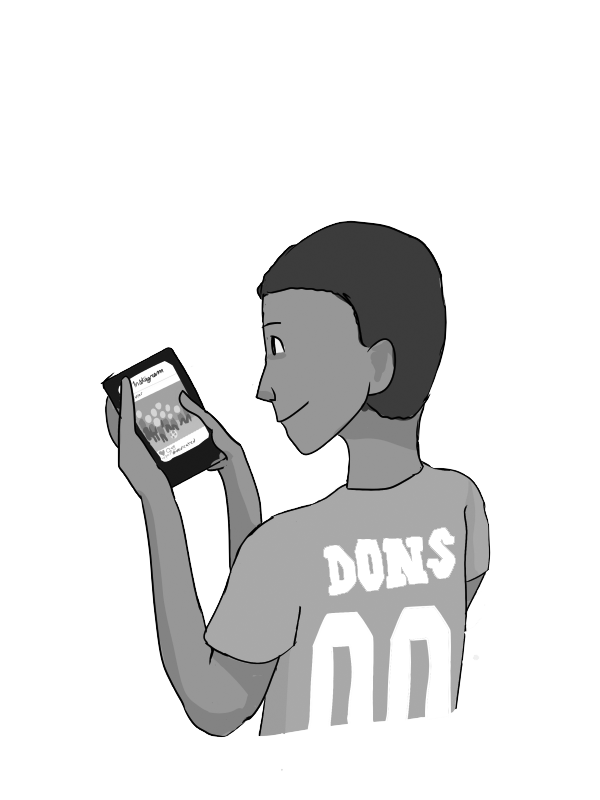
According to a Hootsuite survey, social media is used by almost half of the world’s population and its effects are even more widespread. Posts are constantly going viral and being shared around the world with people who don’t even participate in the popular apps. In the world of sports, these viral posts include training videos, trickshots, highlights, and many others.
These posts’ main home is Instagram. Instagram’s main demographic is high school students. Sprout Social notes that 72 percent of 13 to 17 year olds use Instagram, making them the platform’s biggest audience.

Given that the Aspen Institute’s report says that about 56.6 percent of American children play sports, there’s no doubt that they are looking at athletes’ posts online as well as posting their own images and videos about the sports they play and their accomplishments.
“I like posting about my sports on social media,” said freshman water polo player and swimmer Ruby Vogel. “While water polo is not as well-known, it’s still fun to post pictures of the game afterwards and recap on the highlights.”
Although it’s not as common for teens to post a full photograph or video about their sport, it is relatively common for them to share post-game or pre-game photos on their stories.
“I don’t really post that much, especially about sports” said freshman basketball shooting guard and tennis player Yossi Moff. “But, when I do, I think it would be something big or exciting that happened. Like maybe, we win a game so I would post it on my story.”
But, just because students themselves don’t post that much doesn’t mean that they’re not influenced by other students’ or professional athletes’ posts.
Some of the most common and widespread sports posts are tagged with either #committed or #dedicated. These posts usually consist of game or training highlight reels and can have different effects on athletes depending on how they look at them.
“Sometimes those posts inspire me to want to put in a lot of work into things that I like whether it be sports or not”
“Sometimes those posts inspire me to want to put in a lot of work into things that I like whether it be sports or not,” said freshman tennis player and basketball forward Amitai Smyla. “It’s a good way to show how hard work leads to great results for everything in life, not just sports…it also makes you feel good. It’s like, if I practice, maybe I can get there and kind of follow in their footsteps.”
Even though these posts can be inspiring there are other perspectives on how they can be perceived and reacted too. But, it all depends on the type of athlete.
“I guess on the other hand, sometimes when you see those crazy videos, not that it makes you less willing or less excited about going out there and trying to do that, but it just makes it seem like it’s so far fetched and really hard to get to,” Moff said. “But it’s still fun to try and think you can work up to that and get there.”
Professional athletes have some of the widest reach and influence on young players with the most famous one, Cristiano Ronaldo, having over 164 million followers. These athletes have constant pressure and influence on their followers. One slip up or misbehavior can have a huge impact on a young, aspiring athlete.
For example, in 2012, professional Swedish soccer player Michel Mortadella posted a racist tweet after losing to South Korea. This tweet was seen by thousands and Mortadella was no longer allowed to participate in the London Olympics.
“This is more for professional athletes, but when they have a lot of media around them and they start saying bad things about other athletes it can make other people feel more self-conscious,” Moff said. “It’s not a good feeling when you see other people talking bad about other athletes.”
Social media can also lead athletes deeper into negative stereotypes and expectations.
“I think that social media is generally a great thing for athletes in terms of feedback and influencing us to continue to work hard”
“I think that social media is generally a great thing for athletes in terms of feedback and influencing us to continue to work hard,” Vogel said. “However, it can negatively impact us because…[i]t adds to the slim, trim stereotype that puts pressure on lots of people. It can make people feel self-conscious or embarrassed, which is awful because every body is beautiful.”
Social media also has the power of helping to secure an athlete’s future in their sport.
“I think that one major way that social media can help athletes it to get recognized and to show yourself to the world and to make yourself known,” Smyla said. “If you’re really talented in something and you want to become something in what you do, especially in a sport, you can post a video to show your skills and then people can see you and maybe they can come meet with you and scout you.”
Social media seems to be here to stay with its negative and positive effects. Although there are some negative effects, it’s making better athletes and introducing more athletes into the world. Social media has a future in athletics and athletics have a future in social media.



